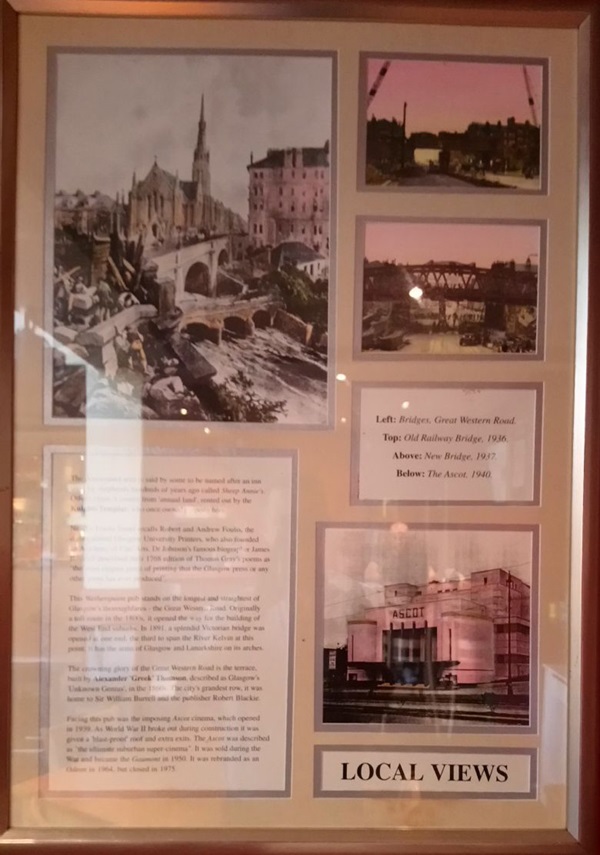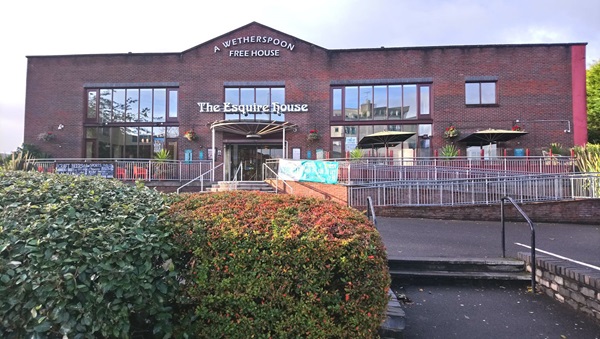The Esquire House was an existing pub taken over by Wetherspoon. The site of this Wetherspoon pub, at what is now 1,487 Great Western Road, appears to have been unoccupied land until The Esquire House pub was built in c1962. Immediately opposite the pub is the imposing former Ascot cinema. A listed building, the cinema made the almost inevitable transition into a bingo hall.
Prints and illustrations about local views.

The text reads: The Anniesland area is said by some to be named after an inn used by shepherds hundreds of years ago called Sheep Annie’s. Others claim it comes from ‘annual land’, rented out by the Knights Templar, who once owned property here.
Nearby Foulis Street recalls Robert and Andrew Foulis, the distinguished Glasgow University printers, who also founded an Academy of Fine Arts. Dr Johnson’s famous biographer James Boswell described their 1768 edition of Thomas Gray’s poems as “the most elegant piece of printing that the Glasgow press or any other press has ever produced”.
This Wetherspoon pub stands on the longest and straightest of Glasgow’s thoroughfares – the Great Western Road. Originally a toll route in the 1800s, it opened the way for the building of the West End suburbs. In 1891, a splendid Victorian bridge was opened at one end, the third to span the River Kelvin at this point. It has the arms of Glasgow and Lanarkshire on its arches.
The crowning glory of the Great Western Road is the terrace, built by Alexander ‘Greek’ Thomson, described as Glasgow’s Unknown Genius, in the 1860s. The city’s grandest row, it was home to Sir William Burrell and the publisher Robert Blackie.
Facing this pub was the imposing Ascot cinema, which opened in 1939. As World War II broke out during construction it was given a blast proof roof and extra exits. The Ascot was described as “the ultimate suburban super-cinema”. It was sold during the war and became the Gaumont in 1950. It was rebranded as an Odeon in 1964, but closed in 1975.
Left: Bridges, Great Western Road
Top: Old railway bridge, 1936
Above: New bridge, 1937
Below: The Ascot, 1940.
Text about Sir William Burrell and William Thomson.

The text reads: Sir William Burrell lived not far from this Wetherspoon pub on Great Western Terrace from 1902 to 1927. His world famous collection of more than 8,000 works of art are on display in a purpose built gallery in Pollock Park. Burrell joined his father’s Glasgow shipping firm as a clerk in 1875 at the age of 14. He retired in 1917 and used his vast fortune to assemble his art collection.
A statue of William Thomson stands in Kelvingrove Park. Better known as Lord Kelvin, Thomson was a brilliant physicist and mathematician.
Educated at Glasgow University from the tender age of ten, Thomson also studied in Cambridge and Paris. He returned to be appointed professor of mathematics and natural philosophy at the age on just 22.
He was there for more than 50 years, and combined his duties with a vast range on inventions and discoveries. One of his proposals, to use a temperature scale based on absolute zero, is known as the Kelvin Scale.
Prints and illustrations of Glasgow in the early days.

Top: Effigies of Knights Templar
Above: The Foulis Academy, 1761
Below: Grosvenor Terrace.

Top: Effigies of Knights Templar
Below: Alexander Thompson.
External photograph of the building – main entrance.

If you have information on the history of this pub, then we’d like you to share it with us. Please e-mail all information to: pubhistories@jdwetherspoon.co.uk